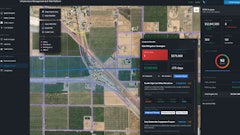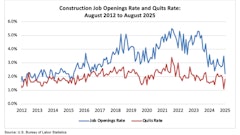
On Wednesday afternoon, August 31, ahead of Labor Day weekend, the Association of General Contractors of America (AGC) and Autodesk held a press conference on the release of their annual joint workforce survey.
The goal of this yearly survey is to "measure the state of construction workforce shortages, better understand why those shortages exist, assess the impacts of labor shortages on construction projects, and learn what firms are doing to cope with and/or overcome those shortages."
According to the press release posted to the trade association's website, almost every single corner of the construction industry continues to experience painful labor shortages. In fact, 93% of firms reported that they have positions they are actively trying to fill, and of those, 91% are having great difficulty finding qualifying candidates to assume those roles. The hardest-to-fill being those in the craft workforce that perform the majority of on-site construction duties, typically the most demanding and physically taxing type of jobs.
The survey conveyed how these staffing shortfalls effect construction firms of all sizes, ranging from less than $50 million in annual revenue, to those in excess of $500 million; and extended across all four regions of the United States. No sector of the industry was excluded. Contractors of building construction, highway and transportation projects, federal and heavy work, or utility infrastructure all reported similar severe difficulties, saying that a majority of those that did apply lacked the qualifications in order to do the work. The survey said, "The most common explanation for difficulty in filling positions, cited by 77 percent of firms is that available candidates lack the skills needed to work in construction or cannot pass a drug test."
The Compounding Issues
More than 80% of those questioned about problems with staffing also reported they were made worse by an increased difficulty to procure essential construction materials, or, even if they were able to order them, their arrival was heavily delayed or all-together uncertain. Subsequently, these combined factors continue to drive up the already high costs due to the rise in inflation blanketing every market in the country.
Seventy percent said they passed along rising materials costs to project owners during the past year. Fifty-eight percent of respondents reported that owners canceled, postponed or scaled back projects due to those increases in costs, while one-third of firms reported projects were impacted due to lengthening or uncertain completion times.
Possible Solutions
Employers are taking steps to address their need for workers, as more than half of respondents are engaged with career-building programs at high schools, college campuses, career and technical education centers. The AGC Inland Northwest chapter launched a combined local and national program called "Trade up 2 Construction", a comprehensive workforce development and community outreach initiative aimed at showcasing construction careers and amplifying interest and employment in the construction trades.
During the press conference Cheryl Stewart, the AGC chapter's executive director, said the project addresses two of what they see as key problems: image and pipeline. "We're launching a media campaign that's going to highlight the hard working men and women of the construction industry and really shines a spotlight on the numerous opportunities and amazing benefits available to those who do join our industry. Next we are hiring a full time industry navigator, [in order to] have someone here locally working with those who are interested to get them [on] the right pathway."
The widest change adopted by firms was launching or expanding their budgets for training and professional development. In addition to that, 86% of respondents reported an increase to base pay rates in the past 12 months, while 45% provided incentives or bonuses and 24% increased their portion of benefit contributions and/or improved employee benefits.
All these changes, on the whole, can be seen as positive steps in the right direction. In combination, they will see success on some levels, and add to their workforce numbers.
There are questions, however, concerning certain gaps or oversights that the survey does not address or speak to directly or indirectly.
Pay vs. Cost of Living
When asked about general figures or percentages in regards to what the AGC press release described as "raises in base pay", the representatives said they did not ask for specific data from the firms surveyed. This isn't unusual, but it feels entirely relevant to place these terms into a greater context of wages and living conditions in the present environment. Why? Because not all raises are equal, especially if they don’t keep pace with costs of living. People can’t get ahead. If the pay can’t elevate a person’s quality of life, why would someone take a job with a heavy physical toll?
As of August 25, 2022, the average base pay nationally for a worker in a construction sector job was $38,013. In 2020, before the pandemic began, that figure was $37,890. That is only an increase of 0.4 percent.
By comparison, according to the Bureau of Labor Statistics (BLS) over the previous 12 month period, ending June 2022, inflation of consumer good increased 9.1%.
One way to view this could be in terms of pure buying power. Entry level construction workers are effectively making 8.7% less than they were before COVID-19, and before the current labor shortage and supply chain crisis.
Of course, there are always outliers to these averages, for example: the top earners in the field of general construction work made $45,831 annually, but the bottom end of that spectrum included entry-level jobs, and those lacking experience which made only $31,000. Importantly, it is far more likely that this is the starting wage accessible to those described by the AGC survey, but again, these are only averages.
In May 2022, the national median rent surpassed $2000 for the first time in history. Of the top 10 areas with the fastest growing rental costs, Austin, Texas took the top spot, New York claimed two, and Florida cities filled 30% of the list. One of the speakers at the AGC press conference, Brandon Bull said of the state, "Florida is really boom town USA. We have an exploding residential construction market, concurrently with that we have several large municipal construction programs taking place, such as palm beach County's infrastructure program. All this has really put a severe strain on the available workforce and material availability in our area."
Notable to that statement, West Palm Beach, Florida was number 7 on the top 10 list of cities with the fastest rising rent costs, increasing by 29% over the last year.
A Local Labor Opinion
During the press conference, a number of contractors spoke about their thoughts and opinions regarding the worker shortages, and gave several similar anecdotes about the challenges they are facing all of which parroted the AGC summary. No one can argue that they are dealing with specific scenarios to their area and their businesses. To get another side of things, Forconstructionprs.com reached out to a member of the Local 396 Chapter of the United Association in Warren, Ohio.
A fifth year pipefitter apprentice, going by the name Matthew Smith, said, "The big problem we have is retention. Kids that are 18 to 21 years old, see us at a job fair, they see sparks and everything like that, and they think it's really cool until they do it for two years and then they quit. Job fairs are cool to introduced people to the trade, but getting people to stay is an issue that I see."
When asked if they noticed any cases where workers tended to fair better, and stay with the profession, Smith replied, "A lot of people that are still there used to be cooks at a restaurant, nurses, people that have already been in the workforce for like, a prolonged amount of time."
A similar line of questioning was presented by forconstructionpros.com during the live press conference, about whether or not the right available labor pools were targeted. Ken Simonson responded , "We haven't just targeted new workers, but we've actually been targeting folks either who've been displaced from the hospitality or retail sector because of the lingering impacts of the pandemic or just because they're they can make more money in construction than many retail and hospitality jobs."
A Void in the Market
One aspect of this crisis not yet addressed is, in reality the largest elephant in the room. According to a Bloomberg report on federal research, "More than 3 million Americans retired early because of the Covid-19 crisis. That’s equal to more than half of the workers still missing in the labor force from pre-pandemic levels." This in addition to more than 1 million American lives lost to the disease itself, even considering not all of those deaths were of working age persons. What is largely ignored by industry associations is the large dearth of labor caused by the COVID-19 pandemic.
What this amounts to is an enormous gap in the market. It can't all be attributed to the common talking points that are frequently repeated, and which many have heard countlessly. "People just don't want to work", "Millennials are lazy", "People make more money on welfare" etc. etc.
These talking points should be rejected, flat out. These kinds of answers offer no solutions, but they do give the simple and immediate certainty of knowing. The issues of labor shortages extend beyond the construction industry. Every industry is dealing with the same exact problems.
The steps that the AGC and Autodesk suggest in their summary are good. Offering more apprentice opportunities, increase spending for training programs and technology, and improve outreach toward the varying labor pools looking for better wages and conditions.
What the industry must decide, however, is whether it can deliver on the promises it makes? Can it meet people where they are, elevate their quality of life? Can some begin to "right the ship"? Those that do, will likely see some of their labor shortage problems start to change for the better. Time will tell between the two.







![Vortex Advantage Boom Truck[21]](https://img.forconstructionpros.com/files/base/acbm/fcp/image/2022/08/Vortex_Advantage_Boom_Truck_21_.630ccaeba8b50.png?auto=format%2Ccompress&fit=crop&h=167&q=70&w=250)












